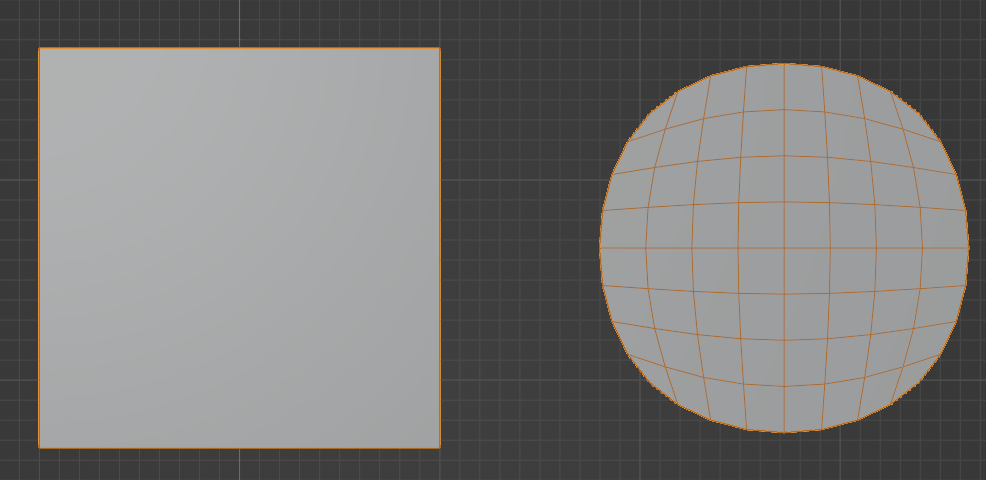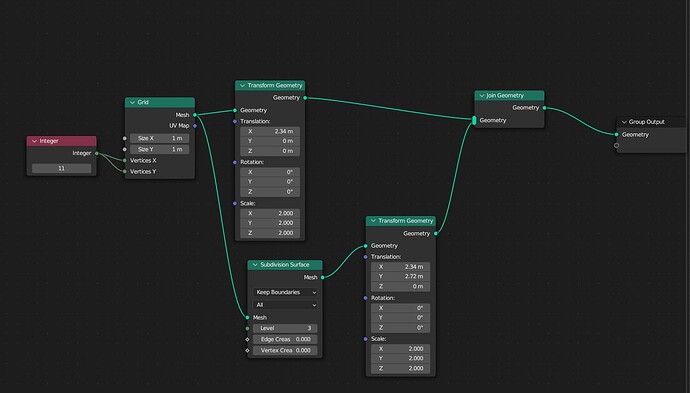Your Scale Elements make no sense… why are you doing scaling around the bounding minimum?
Tbh I just learned what the bounding minimum is. I have already collapsed the vertices of the bounding box to center cause I didn’t want to see it any more.
Most of this has been assemble by @dan2… I added one last scale before output.
I still have yet to experiment with trying to add the squircle feature… I want to add another parameter to the main module (in green) that modulates the rounded corner aspect.
Thank you for what you’ve shown so far. Any reading or tutorials you have to share, I will study. I have no idea how to do exactly what you suggest. When I adjust the XY resolution parameters on the module you made, The corners stay a rigidly square. No rounding what so ever. Just less intersects on the mesh grid which eventually create jagged edges as a lower the resolution.
You will need a subdivision surface node as well. As you lower the resolution, you up the subdivision level as needed -
You can try the concept on a simple grid -

My thinking was that you probably don’t care about changing resolution as you’d print the object, and since you potentially wanted to use some math, staying inside geometry nodes would probably be practical.
Note that you’d need the circle resolution to be divisible by 8, to get an even rounding.
The bounding minimum was used to do a single axis scale from the base, not the center.
Can I use python and ChatGPT to guide me through some of this?
You tried some of the
- suggestions from people with
- Geometry Nodes already.
So why now use python with the help of AI ??
my main issue is reverse engineering what has been done so far…
I’ve been using Ai to guide me through some basic blender execution’s, so I guess I should just keep going.
2 of the answers literally gave you .blend files:
Doesn’t sound like AI is helping you at all if after 3 months you still have nothing to show. Maybe your biggest problem is that you are using AI.
Good luck.
I repeat, give a man fish or teach a man to fish. I just started looking into this project recently, and realize that reverse engineering this is not a breeze… Yeah he gave me something that is fulfilling my needs… Dan2 did… I just wish to understand it.
I wish to be able to create what Dan2 gave me from scratch… at this point it is still a foreign language
“How to design Horn shapes in Blender, using tractrix formula, and exponentials”
This question has been answered. - modulate a curve’s profile radius using the tractrix formula… done. There is nothing to “reverse engineer”, you just need to know basic things:
- What a curve is.
- What a curve profile is and how it is affected by curve radius.
- Basic high-school math.
If you are really that much of a beginner, don’t ask how to catch tuna when you don’t even know how to hold a fishing rod. Start smaller - try learn how to catch something like a sunfish first.
Good luck.
<sarcasm attribute='friendly'>
So there where mutliple explanations about fishing ( this horn shapes)… from using
- knowledge of fish and water ( mathematics )
- an angle ( modeling a curved shape )
- a net ( geometry nodes )
…and now you want to use a boat ( python )… and someone to tell you how to make all this so you can do the fishing ?
</sarcasm>
![]()
…or… back to the extra addon:
Z= max(-2, log(sqrt((cos(u)*sin(v))**2+(sin(u)*sin(v))**2)))
no +0.001 needed as in the image
Incorrect - Nothing anyone has done is useable except for what Dan2 has provided. The float curve allows me to define the curve, the beginning diameter and end diameter. What he created is obviously the way and I don’t see any math involved. The reverse engineering of the geometry node recipe. Can you help?
What? I gave you step by step directions for my method, with written explanations and screenshots for each step. You’re not endearing yourself to getting help in the future by being so dismissive of people’s time and effort to help you
I am not dismissing anyone’s help, I am helping you, help me. Of course I appreciate you and anyone who takes time out of their day to respond to me and help me on my endeavor. I also am not trying to waste peoples time, thats not fair. I want to learn how how he created this geometry node matrix.
When people give you a blend file it is not just giving you the fish, it’s giving you the rod, the bait, and your own pond packed full of the little blighters, ready for you to get in there and practise catching them yourself.
There is a limit to what can be taught to you on the forum, and you are trying to jump into Blender with a more advanced project, which makes it harder to guide you. No amount of “explain this node group to me” is going to make it easier, because people don’t know what you’ve actually tried to understand for yourself.
Make a backup of Dan’s file so you can go back to it if you get utterly lost, and play around and see what does what. Break things, work out how to fix them, and generally just mess around. Try to recreate the whole thing from scratch by finding his nodes in the node menu, connecting them, and manually adding the values.
If you can have a play like I suggest above much of it should become clear, with maybe a few nodes still not making sense that you can then come back and query: “I’ve done this thing, but I still don’t get how X node works and why”. This is how you learn to fish. What you are currently asking is how fishing works, which is not the same thing.




